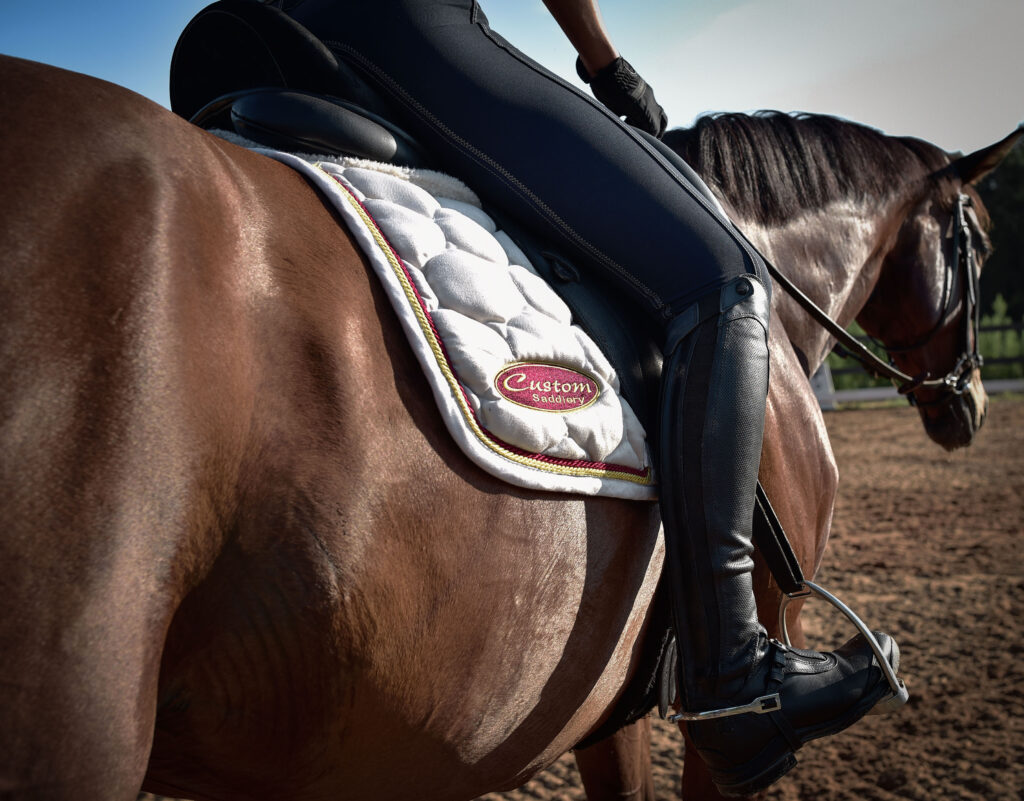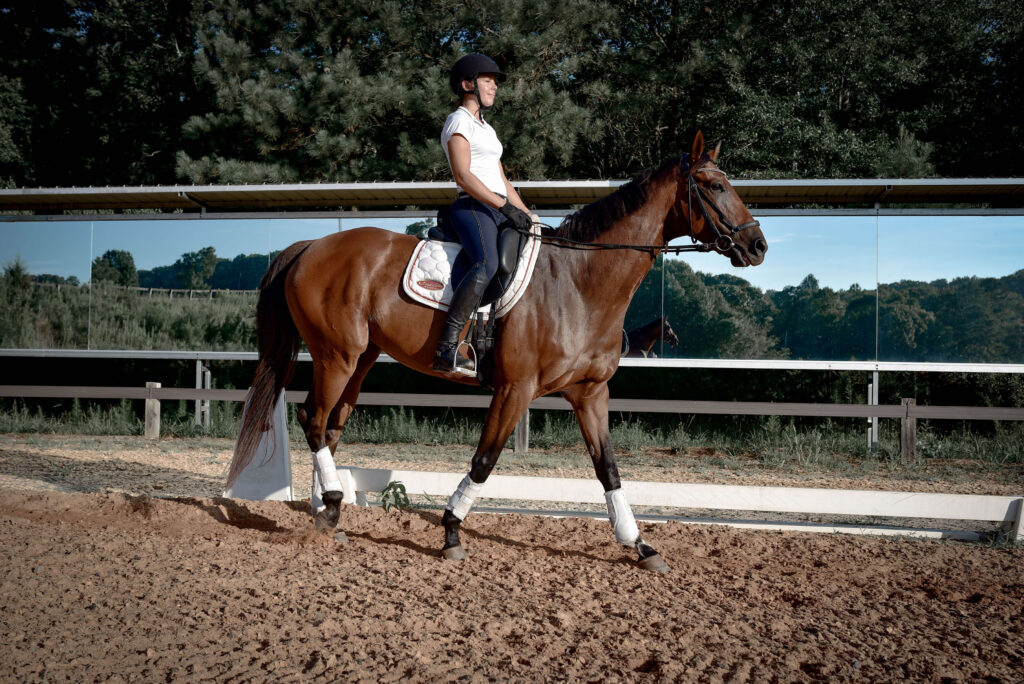The world of classical dressage with Carmen Mesbergen
March 30, 2024

She has communicated plain, practical, and pedagogic direction to hundreds of young riders. Her forte is originating light and fun horseback riding experiences. From training basics to competitive lifestyles, Carmen Mesbergen, 33, teaches both horse and rider the rudiments of modern horsemanship. Originally from Loveland, Colorado, the seasoned equestrian developed an affinity for classical dressage and traveled Europe as a presenter and rider. Now back in the States, she’s made Forsyth, Georgia, home as head trainer at Marigold Stables – a 52-acre, privately owned equestrian center. Teaching riders harmony with horses using the body, Mesbergen naturally helps the two become one in the arena. A Justin Boots visit to Marigold became an opportunity to learn how she entered the world of English riding and gain pro tips to identify the best riding stables home and abroad:
Q: Your arena resume is pretty extensive and impressive. To start, what was your introduction to horses? A: I grew up on a working cattle ranch in Colorado. My mom likes to remind everyone I rode before I was born. At the time, riding Western was a way of life for us on the ranch. I later expanded my knowledge by showing at American Quarter Horse Association (AQHA) all-around projects. I trained as a kid and was heavily involved in 4-H where I showed beef steers – which helped pay for the horses. I also judged for several years through 4-H and AQHA Youth Horse Judging. Barrel racing and arena runs came from my two years as a 4-H county fair princess. Yes, I still have my hats and sashes in a box somewhere.
Q: Lol. That’s too cute. We’re huge fans of both AQHA and 4-H to get youth started early in agriculture and cowhand culture. So when did you make the “jump” from Western to English riding? A: I always loved learning to work in better harmony with my horse and literally jumped anything I could on the ranch. Sagebrush. Swimming rivers. When I was finally able to take jumping and dressage lessons at 13 years old, the opportunity was such a dream come true. I first trained professionally in Denton, Texas, then back to various barns in Colorado. Now Georgia, of course. Before that, I rode for the past three years in Europe. First, a sales stable in Germany. Then, eventing in Belgium. Dressage in Holland, and show jumping in Norway and France.

Q: You’ve been one traveling cowgirl, and we’re here for it. It’s interesting that you’ve straddled both Western and English riding. Do you prefer one style over the other? A: Good riding is good riding at the end of the day. Each style should enhance one another, not detract. I use much from classical dressage training to work with horses from Western backgrounds so that they can better understand the rider’s cues, and how pleasant riding can feel for both horse and rider.
Q: Good advice to merge the two. Now for families curious about taking dressage lessons, what are your top three pro tips for identifying the best stables for lessons? Any watch outs when researching this form of outdoor recreation? A: Yes, you want to pay attention to the trainer’s knowledge and background about this space. What’s the trainer’s genuine relationship to horses and contributions to the industry? A big watch out is safety. It’s important that everyone on the property – especially new or beginner riders – feel safe. Safety is priority. I can’t stress that enough. Even when first-time riders visit the stables and interact with the horses. This point includes making sure horses feel and are safe, too. That they are well-trained. Lastly, I would say observe your surroundings. Is the arena in good condition with decent footing? Always be leery of those who speak ill of others and don’t clearly love their horses. The best trainers do more than say more. Their work speaks for itself.
Q: Thank you for these callouts to determine the right riding locations. So, we’re in the saddle. What can we learn from dressage? The lessons behind this type of riding style? A: Patience. And more patience. Dressage pushes your mental and physical limits in a way that you have to always think about another living being (the horse in this case). Making sure your own desires remain consistent with that being’s greater happiness. I’ve had students as young as 3 or 4 fall in love with their first horse experience and dressage. At that age, it’s all about the senses and soaking in every interaction with the horse as only they can understand it.

Q: We love how young your students are to build early relationships with horse culture. For youth who are competitive in nature – as I was as a kiddo – what advice would you give them as their riding career advances? A: The things in life most worth doing are usually the hardest to master. Practice does not make perfect, but perfect practice does. Like all of life, riding is not easy. You have to think calmly about what you’re doing, especially when you’re most frustrated. Check that ego at the door. And never, ever give up.
Q: Well said. Transitioning from my childhood roots of Western riding to English has been quite the challenge for me personally. I literally had to deprogram most of what I learned as a kid, so I understand exactly what you’re saying. At Justin, we live for travel stories. Why should readers plan a trip to Marigold Stables here in Georgia? A: We offer all types of lessons – from beginner, first-day around horses to competitive jumping and dressage. Most of our current students are jumping-focused, which is natural for youth riders. I’ve already shown them the necessity of dressage for better jumping. It’s fun to bring that into a barn that has previously attracted more eventing and jumping, showing students just how exciting dressage actually is. We also have a beautiful Olympic-size dressage arena with mirrors with great footing. And with roughly 25 horses at the stables, we’re home to American paint horses and even a KWPN Dutch Warmblood imported from Holland.
Q: My favorite horse by the way and a gentle giant, indeed. OK. Bonus question to wrap up our lovely time together: What are your favorite boot brands in both the Western and English arenas to both train and compete in? A: Great question! I love my Ariat Heritage V Sport tall boots to ride and train in. They’re really comfy. Now, I do have a nice pair of square-toed, ostrich-skin Justin Boots, but those are for dancing.